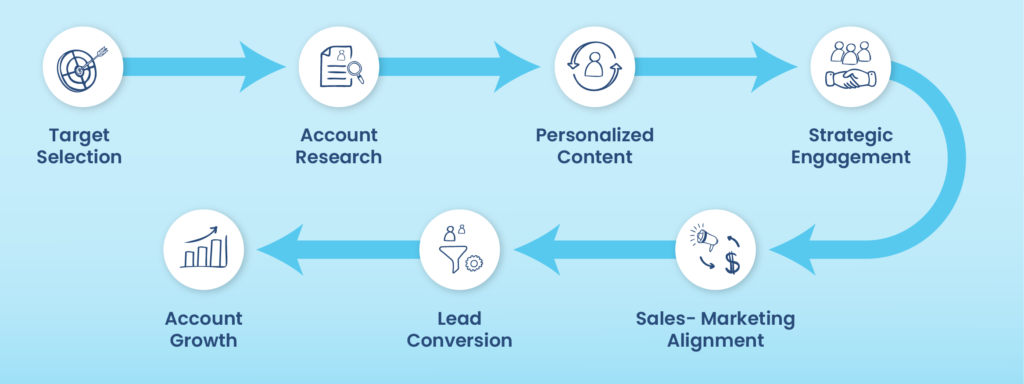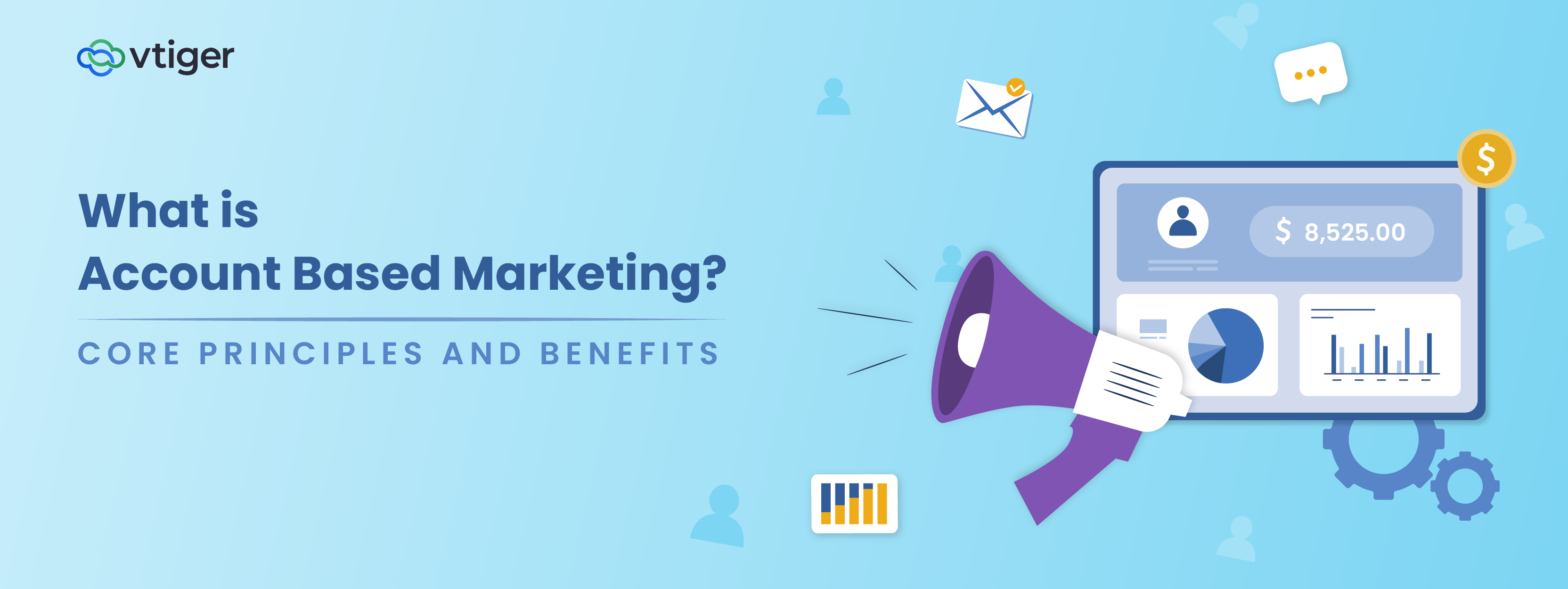Account-based marketing (ABM) is a strategy in B2B marketing where marketing and sales teams work together to target and engage specific high-value accounts. Instead of trying to reach as many leads as possible, ABM treats each target account as its own, tailoring campaigns and messaging to address the unique needs and challenges of that account.
According to Gartner, 79% of marketers believe that personalized content improves customer engagement. This shows why ABM is gaining more attention across industries. Keep reading further to learn about its core principles and the systemic benefits after applying this strategy.
Account-Based Marketing Explained with a Simple Example
To understand how account-based marketing works, let us compare it with traditional marketing using a simple example from the SaaS industry.
In traditional B2B marketing, a SaaS company may run broad campaigns like mass email campaigns, online ads, or webinars to reach thousands of businesses at once. The goal is to attract as many leads as possible and then qualify them later. This often results in lower conversion rates and a lot of unqualified leads.
Now, with ABM, the approach is more focused. Here’s how it would work step by step:
- Identify target accounts: The company selects a list of high-value enterprises based on factors like industry, revenue, and potential fit.
- Research each account: The marketing and sales teams gather insights about the decision-makers, business needs, and current challenges at each selected company.
- Customize the message: Instead of a generic pitch, the company creates content pieces such as case studies, demo videos, or emails that speak directly to the needs of each target account.
- Engage across channels: They use personalized LinkedIn outreach, targeted ads, and 1:1 emails to reach the right people within the organization.
- Measure and adjust: The performance of each account-specific campaign is tracked, and strategies are modified accordingly.
This focused method increases the chances of converting large enterprise clients while reducing wasted effort. With account-based marketing explained through this structured approach, it’s clear why more B2B companies are adopting it to drive results.
How Account-Based Marketing Works: Step-by-Step Process
Account-based marketing is less about marketing to the masses and more about building bridges with a few high-value clients. Imagine replacing a billboard with a direct conversation—every message, every campaign, every move is crafted for a specific business. Here’s how account-based marketing works in practice:
- Zero in on High-Value Targets
Begin with precision. Instead of chasing hundreds of random leads, choose a handful of companies that align closely with your offering. These could be large enterprises or strategic industry players.
- Assemble a Cross-Functional Strike Team
Every department, such as marketing, sales, and product teams, unite with a single goal: winning important accounts. In this, everyone is expected to share insights and align their efforts to create more personalized approach for each account.
3. Dive Deep with Research
You’re not selling to a company, you’re solving a problem for a specific group of people within that company. Research who the decision-makers are, what their pain points look like, and how your solution fits into their larger goals.
4. Craft Tailored Campaigns
Forget templates. Build content that speaks directly to each account’s needs, whether that’s a custom pitch deck, a personalized video, or a case study that mirrors their challenges. When your outreach feels one-of-a-kind, it earns attention.
5. Sync Sales and Marketing Movements
The left hand must know what the right hand is doing. Sales and marketing should align messaging, share learnings, and adjust tactics together. This unified front ensures the account sees consistency, not confusion.
6. Engage with Intent and Value
Every touchpoint should add something meaningful. Share resources that educate, not just persuade. Host invite-only webinars, offer consultations, or send strategic updates. The goal is to earn trust before expecting conversions.
7. Track, Learn, and Refine
Measurement isn’t just for performance; it’s for improvement. Monitor how each account responds and use that feedback loop to fine-tune your campaigns. ABM evolves; the more you learn, the better you target.
Sample ABM Funnel:

If you’re wondering how ABM works, think of it as high-touch, low-volume marketing built on insight, alignment, and mutual value. It’s designed not to attract everyone, but to win over a few.
Core Principles of Account-Based Marketing
Account-based marketing is built on a set of key principles that ensure each effort is aligned, targeted, and results-driven. These principles guide how teams operate and how communication flows across different marketing channels. Here is a closer look at each one:
1. Alignment between Sales and Marketing
This principle ensures both sales and marketing teams work with a common understanding of goals and target accounts. They should plan together, share data, and coordinate messages across platforms such as customer relationship management tools, email communication systems, and lead tracking software. When both teams move in the same direction, account engagement becomes more consistent and effective.
2. Personalization at Scale
In account-based marketing, every communication with a potential client must feel highly relevant. This involves creating customized email sequences, tailored advertisements on platforms like LinkedIn or Google, and dedicated web pages for each account. Even when reaching many accounts, the message should always reflect an understanding of the client’s unique needs.
3. Targeting High-Value Accounts
The foundation of ABM lies in selecting the right businesses to engage with. These are often companies that show clear potential for high revenue, long-term partnership, or strategic value. Selection is done using data filters based on company size, location, industry, or digital behavior. Marketing efforts are then directed toward these accounts using a mix of direct outreach, targeted ads, and curated content.
4. Insight-Driven Strategy
This principle involves gathering detailed information about each target account before engaging them. Insights may include recent company developments, leadership changes, pain points, or market positioning. These insights guide the creation of meaningful campaigns delivered through webinars, case studies, personalized presentations, and relevant social media content.
5. Long-Term Relationship Building
Rather than focusing only on conversion, ABM emphasizes building strong, lasting relationships. After an account becomes a customer, engagement should continue with helpful newsletters, check-in calls, exclusive content, and value-added updates. The goal is to support the customer’s growth and create opportunities for account expansion over time.
Benefits of Account-Based Marketing for Global Businesses
The benefits of account-based marketing are relevant for companies tackling long sales cycles, complex buying committees, and high-value enterprise deals. Discover how ABM drives measurable impact across critical business functions:
- Maximised Return on Marketing Investment
Rather than casting a wide net, ABM focuses resources on accounts that demonstrate a high fit and strong intent. The result is not only better conversion rates but also a measurable uplift in cost efficiency and campaign attribution accuracy.
- Operational Synergy Between Sales and Marketing
ABM compels sales and marketing teams to operate with shared KPIs, unified messaging frameworks, and account-specific activation plans. This collaborative rhythm ensures continuity from first contact to deal closure, reducing friction across buyer journeys.
- Sharper Budget Allocation
In contrast to channel-based planning, ABM budgets are structured around account clusters and lifecycle stages. This allows businesses to optimise spend based on revenue potential instead of audience size.
- Acceleration of Enterprise Deal Timelines
By targeting already-qualified stakeholders with tailored engagement strategies, ABM reduces redundant touchpoints. For service-based firms, this means faster movement through procurement cycles and fewer delays caused by internal alignment at the client end.
- Hyper-Personalised Buyer Engagement
Each interaction under ABM is designed to reflect the account’s business context, industry challenges, and decision dynamics. For a market environment where trust, familiarity, and customisation matter deeply, this level of specificity leads to higher deal velocity and stronger rapport.
- Pipeline Precision and Quality Uplift
The ABM pipeline is not about quantity but relevance. Every opportunity that enters the funnel is already aligned with your product’s value proposition, reducing unqualified leads and boosting sales team productivity.
- Sustained Client Value and Upsell Opportunities
ABM continues beyond the sale. Through post-conversion engagement, it strengthens account relationships, identifies whitespace, and enables structured upsell and cross-sell motions.
- Deeper Insight into Campaign Effectiveness
Because ABM tracks metrics at the account level, performance evaluation becomes more granular and meaningful. B2B teams can assess success using metrics like account engagement, multi-touch attribution, and influence on deal expansion. Note: Account engagement helps you understand how actively your company is interacting with the brand. Multi-Touch Attribution reveals the interactions that influenced the deal. Deal Expansion shows you how your efforts contributed to increasing the size of a deal, such as upselling or cross-selling.
ABM vs Traditional Marketing: Key Differences
For B2B strategies, especially in enterprise settings, understanding how ABM contrasts with traditional marketing is essential for choosing the right go-to-market approach. The table below offers a clear, side-by-side comparison to guide marketing leaders and growth teams:
| Feature | Account Based Marketing (ABM) | Traditional Marketing |
| Target Audience | Prioritizes a curated list of high-potential accounts, often selected through predictive intent signals and Ideal Custome Profile (ICP) fit | Targets broader audience groups based on static demographic or industry-level segmentation |
| Campaign Approach | Operates on hyper-focused initiatives crafted around each account’s buying journey and organisational pain points | Launches mass campaigns using a uniform message, regardless of account maturity |
| Tools Used | Relies on intent platforms, ABM orchestration tools, CRM intelligence, and multi-touch engagement stacks | Utilises traditional CMS, email suites, ad exchanges, and basic segmentation software |
| Metrics Tracked | Tracks depth of engagement at the account level, pipeline acceleration, and influenced revenue | Measures leads generated, ad impressions, CTRs, and campaign-level ROI |
| Sales-Marketing Alignment | Built on a shared revenue pipeline with coordinated roles, joint KPIs, and unified account engagement plans | Often functions in silos, where marketing generates leads and sales works downstream |
| Content Strategy | Develops modular assets like industry-specific playbooks, executive briefs, and stakeholder-aligned messaging | Uses generic content assets distributed uniformly across channels |
| Conversion Path | Account journeys are dynamic, multi-threaded, and aligned to specific decision-makers across buying stages | Funnels are typically linear, focused on lead generation and hand-offs |
| Customer Focus | Built for depth. Emphasizes customer expansion, retention, and relationship capital within named accounts | Primarily acquisition-oriented, with limited lifecycle or post-sale personalisation |
Types of Account Based Marketing Strategies
Account-based marketing adapts to how closely you want to engage with potential clients. The level of personalization, volume of target accounts, and depth of outreach define the model you choose. Below are the three core ABM strategies, each suited to a specific level of scale and resource availability:
1. Strategic ABM (1:1)
This model centers on precision targeting. Each account is studied thoroughly, with communication tailored to that company’s internal goals, industry pressures, and stakeholder expectations.
They are suitable for enterprise tech providers or consulting firms targeting large conglomerates, government bodies, or global corporations. These accounts typically involve complex buying committees and long decision cycles, making highly personalized engagement necessary.
2. ABM Lite (1:few)
ABM Lite targets a small group of accounts that share common characteristics such as industry, company size, or solution needs. While not as tailored as Strategic ABM, it still includes focused content, segmented messaging, and channel-specific delivery.
It is well-suited for mid-sized firms offering SaaS, legal advisory, or compliance services, looking to engage sectors like BFSI, logistics, or mid-cap manufacturing. This approach balances customization with scale.
3. Programmatic ABM (1:many)
Programmatic ABM uses technology platforms and intent data to run scalable campaigns across a large volume of accounts. Personalization is rule-based and segmented, allowing automated delivery of industry-relevant messaging at speed.
Best for cloud software vendors, fintech platforms, or B2B marketplaces targeting thousands of SMEs across different regions. Ideal for lead generation where personalization needs to be efficient and data-driven.
Is ABM Right for Your Business?
Account-based marketing is not a one-size-fits-all solution. It thrives under specific business conditions. Use the checklist below to assess if ABM aligns with your goals and setup:
- Do you target a well-defined set of high-value accounts rather than a broad market?
ABM delivers the most value when your focus is on winning specific clients who bring significant revenue or strategic impact. If you already segment your leads based on account size, industry, or lifetime value, ABM fits naturally into your approach.
- Is your sales cycle long and dependent on multiple stakeholders?
Businesses selling high-ticket products or services often navigate extended buying cycles involving CXOs, procurement heads, and technical evaluators. ABM is designed to engage each of these roles with tailored content and touchpoints.
- Is your sales and marketing team ready to collaborate beyond handovers?
ABM requires real-time sharing of account intelligence, joint KPIs, and integrated execution. If your teams already work closely or are moving in that direction, ABM will amplify their combined impact.
- Do you have a working CRM or marketing tech stack in place?
While ABM platforms exist, getting started can be as simple as using tools like Vtiger CRM software, or even LinkedIn and email automation. What matters is the ability to track accounts, personalize outreach, and measure engagement.
- Are you focused on building long-term client value rather than just generating leads?
If your revenue model depends on client retention, repeat business, or multi-year contracts, ABM can help you nurture and grow those relationships meaningfully.
- Is your marketing budget better spent on fewer, more qualified prospects?
ABM reallocates effort from mass marketing to precision engagement. If you’re looking to reduce waste and improve conversion efficiency, this strategy makes financial sense.
If you answered “yes” to most of these, your business is well-positioned to implement ABM and see measurable outcomes.
How to Get Started with ABM
Account-based marketing might sound like something only large enterprises can afford, but the truth is, small and mid-sized businesses can benefit just as much, if not more, by taking a focused and resource-efficient approach. Here’s how to get started in a way that’s practical and scalable:
1. Define Your Ideal Customer Profile (ICP)
The foundation of ABM is knowing exactly who you want to target. Define your ideal customer based on factors like industry, size, revenue, business goals, and key decision-makers. Think beyond basic demographics. Consider the kinds of problems your product solves best and the type of company that would truly value what you offer.
For example, if your product helps automate payroll, your ICP might be mid-sized companies with growing HR teams and a need for compliance-friendly processes. The clearer this profile, the more focused and effective your campaigns will be.
2. Align Sales and Marketing Teams
In traditional lead generation, marketing passes leads to sales. In ABM, both teams own the same goal — converting specific high-value accounts. This requires close coordination, not just occasional updates.
Set shared targets, define the customer journey together, and make sure both teams agree on messaging, outreach strategy, and success metrics. Even in a lean team, this alignment can be your biggest advantage — faster feedback loops, less guesswork, and better client conversations.
3. Use Tools That Fit Your Size and Goals
You don’t need high-end software to practice ABM. Most businesses already use tools that can be repurposed. A basic setup might include:
- A CRM to manage contacts and track interactions
- An email tool to create personalized communication journeys
- A research process for understanding account needs and decision-makers
- A way to measure engagement, even a spreadsheet, will do in the beginning
Focus on visibility, personalization, and clarity. As long as you can see who’s engaging, respond quickly, and track progress, you are doing ABM right.
4. Run a Small Pilot Campaign
Start small. Pick 5 to 10 companies that closely match your ICP. Build custom messages, content, and outreach based on their specific business goals or pain points. This could mean sending a personalised pitch deck, writing a tailored email, or even calling the decision-maker directly with a relevant insight.
Keep the campaign timeline short and focused. Measure success based on how well the account engages, how many conversations are opened, and how far the deal moves in the pipeline. Use these insights to refine your approach before scaling.
Why Vtiger CRM is the Best Tool and Platform for ABM
Account-based marketing thrives on precision, coordination, and personalization—and that’s exactly where Vtiger CRM delivers unmatched value for businesses. Here’s how it ensures every message feels personal and relevant:
Unified Account View for Cross-Team Alignment
Vtiger’s consolidated account profiles enable sales, marketing, and service teams to access real-time data from a single interface. This eliminates information gaps, shortens response time, and ensures every customer interaction is based on the latest context and status.
Automation Designed for Buyer Journey Precision
The automation features of the platform extend beyond work efficiency. Teams may plan outreach based on buyer indications with the use of drip campaigns, behavioural triggers, and lead scoring systems. For ABM to be successful, this guarantees that messaging is relevant, timely, and in line with account intent.
Adaptability for Varying Operational Models
Vtiger’s modular design allows for customization across verticals and sales structures. From regional hierarchies to multi-contact buying units, the CRM can mirror your internal workflows without adding complexity. Its low-code setup makes it suitable for SMBs aiming to scale ABM incrementally.
Integrated Outreach Across Channels
Vtiger influences targeted engagement through a range of native channels like email, SMS, voice, and web. With campaign analytics tied directly to account records, teams can measure effectiveness without relying on fragmented tools or external integrations.
| Further Reading Suggestions | ||
| What is a CRM | Open Source CRM | Sales CRM |
| Evolution of CRM | Analytical CRM | What is a Recruitment CRM |
| What is AI CRM | Mobile CRM | What is the CRM Process |
Common Challenges in ABM (And How to Overcome Them)
Even the most promising Account-Based Marketing plans can hit roadblocks—especially in fast-moving or resource-conscious environments. Below are common friction points and how teams can address them without derailing strategy.
1. Lack of Alignment Between Sales and Marketing
ABM initiatives often falter when sales and marketing teams operate in silos. Disjointed communication leads to inconsistent messaging, missed opportunities, and fragmented customer experiences.
To address this, begin with a unified Ideal Customer Profile and ensure both teams collaborate on account selection and messaging. Joint planning, shared KPIs, and synchronized outreach efforts can help teams operate with clarity and cohesion.
2. Inaccurate or Incomplete Data
Account-based tactics require accuracy, and even the most well-planned campaigns can be derailed by subpar data. Ineffective targeting frequently results from obsolete corporate details or missing contact information.
Regular data hygiene practices like deduplication, enrichment from reliable sources, and validation rules within your CRM can dramatically improve targeting accuracy and campaign efficiency.
3. Complexity of Tools and Technology
A fragmented martech stack can become a bottleneck. Too many disconnected systems can hinder execution speed, reduce transparency, and overwhelm teams.
Simplifying your stack by choosing platforms that offer built-in integrations or unified features can reduce operational friction. Prioritize tools that offer scalability, allowing your team to grow into advanced capabilities at its own pace.
4. Budget Constraint
High-value targeting can be seen as a luxury, particularly for smaller teams with limited marketing budgets. But lack of scale doesn’t have to mean lack of impact.
A phased ABM approach, like starting with a few strategic accounts and leveraging existing platforms, can prove early success without straining resources.
5. Difficulty Measuring ABM Effectiveness
Traditional lead-based metrics fall short in evaluating ABM performance. Without account-level tracking, it’s challenging to understand engagement or pipeline influence.
Instead, adopt metrics tailored to ABM: account engagement scores, deal velocity, and expansion opportunities offer a clearer picture. Aligning reporting tools with account-level visibility helps teams refine their strategy with measurable outcomes.
Conclusion: ABM Is About Focused Growth
Account-Based Marketing is not about chasing volume. It’s about investing effort where it matters most on accounts with true potential. The approach connects strategy with precision, bringing marketing and sales onto the same page. You don’t need a large team to start; you need the right direction.
Even a small-scale ABM implementation, when guided by clear intent and actionable insights, can drive meaningful outcomes. If your next goal is to scale with precision, consider speaking to an ABM specialist. Reach out today for comprehensive, hands-on guidance.
FAQs on Account-based Marketing
The primary goal of ABM is to drive growth by targeting high-value accounts with tailored marketing and sales efforts. It focuses on deeper engagement, better conversion rates, and long-term business relationships instead of broad lead generation.
No. While enterprises use ABM at scale, smaller businesses can apply it selectively to pursue key clients. A focused, resource-light ABM approach can still deliver high ROI when planned well.
Yes. Startups targeting niche segments, large enterprises, or B2B verticals can use ABM to cut through the noise, personalize outreach, and fast-track strategic deal closures.
Traditional email marketing targets a broad list, usually with generic content. ABM is more precise, it builds campaigns for specific companies, using insights to craft relevant messages that match each stage of the buying journey.
B2B tech providers, SaaS firms, consulting agencies, and manufacturing suppliers are increasingly adopting ABM to win complex, high-value deals in sectors like BFSI, healthcare, logistics, and IT services.
Not necessarily. You can start with existing CRM and email tools. However, ABM-specific platforms help with account targeting, personalization at scale, and performance tracking as you grow.
It depends on your scope. ABM can be lean and cost-effective when done for a few key accounts using existing tools. Costs rise as you scale or adopt advanced tech, but returns often justify the investment.
Track metrics like account engagement, deal velocity, influenced pipeline, and retention. Unlike generic campaigns, ABM success is tied to account-level outcomes, not just clicks or open rates.
Initial traction can start in a few weeks, especially in pilot campaigns. Full impact on sales cycles and account growth usually becomes clear over 3 to 6 months.
Absolutely. ABM and inbound can work together. While inbound brings in leads organically, ABM targets high-priority accounts with precision, and both strategies can run in parallel for balanced growth.



